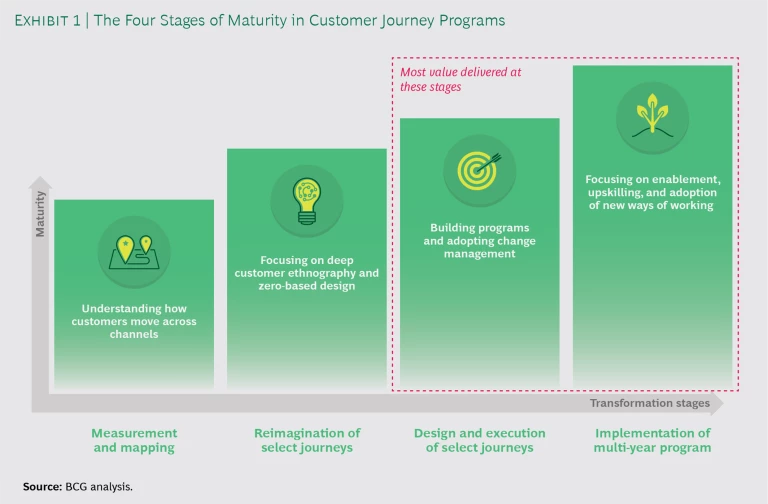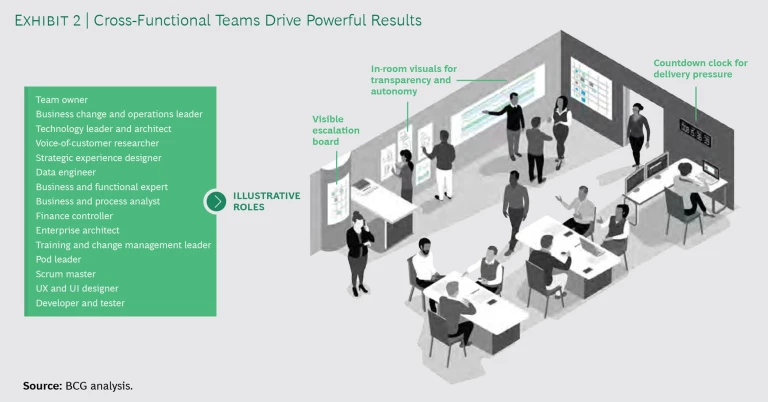Customer journey programs have been around a long time but too often fall short of lofty expectations. In many cases, companies are left with little but attractive visual maps of reimagined customer journeys. What starts as a well-intentioned initiative often flounders in human-centered design labs or customer experience departments. Unless companies adapt their culture, processes, operating model, and ways of working at scale, they will achieve only partial and narrow success.
This is a missed opportunity. Customer journey programs can provide improvements of 20 to 40 points in customer advocacy scores, cost reductions of 15% to 25%, and revenue increases of 10% to 20%. It’s also a hard opportunity to capture.
What Is Different About Customer Journeys
A customer journey is simply a way to describe the chain of interactions that begins at the moment a customer perceives a need—“I want help to resolve my service issues” or “I want to buy a home”—and continues until the need is satisfied.
Companies cannot solve customer needs within the traditional organizational silos.
The front, middle, and back offices must work on these customer journeys together. Companies cannot efficiently solve these needs within traditional organizational silos because journeys cut across existing functional departments, technology platforms, and channels. It requires a horizontal approach that is literally at odds with the strong, highly specialized, and internally efficient vertical silos within many companies.
Companies should flip their orientation, viewing these journeys through the eyes of their customers. In doing so, they will discover the need to fundamentally alter their operating model. To reach scale with customer journeys, it takes a transformation that unfolds in four stages. (See Exhibit 1.)
What Goes Wrong?
What is it about customer journey transformations that companies do not understand? In our work across industries, we have found six common themes in programs that fall short.
The programs have ambition but no plan. Many companies have customer experience goals. Far fewer articulate coherent plans. The customer experience priorities may be disconnected from strategic goals such as growth or efficiency, so employees, leadership teams, and business lines may not be on board with the hard work needed.
They define the journeys too narrowly. When defining a customer journey, many companies focus on narrow episodes of a customer’s experience—the onboarding or payment process, for instance—rather than on a broader concern or need. Other episodes include marketing, application submission, application review, and so on. This focus on transactional touchpoints reinforces siloed ways of working. For customers, all of these touchpoints are parts of the same journey.
Scaled customer journey programs and traditional, top-down decision making do not mix.
They keep working in the traditional setup. Scaled customer journey programs and traditional, top-down decision making do not mix. Too many companies try to create customer journeys within silos rather than across them, leading to duplication of effort and diffusion of effect. Customer journey programs cannot work unless they are cross-functional and front to back in scope.
They fail to follow through. Some teams spend most of their time creating compelling maps of customer journeys and pictures of customer personas and not enough time on people, process, operating-model, and technology changes. A picture may be worth 1,000 words, but it can’t create transformational impact.
Their pilots are set up to fail from the start. The initial set of customer journeys needs to be compiled carefully. If they are too limited in scope or reach, the journeys may have difficulty attracting top talent, making meaningful change, or garnering management attention. These initial journeys need to be sufficient in ambition and potential.
They measure success too narrowly. Many companies pay attention to the wrong metrics when they launch customer journey programs. They focus on general sentiment, such as overall company NPS, rather than metrics specific to each journey and each episode within each journey. Many companies do not tie customer metrics with operational and financial performance metrics, creating a chasm between customer journey teams and the overall work of the company.
How to Create a Transformation That Delivers Value
Successful companies have avoided these missteps through vision, focus, scale, and scope. Here’s how they do it.
Develop a bold ambition and specific plans. Organizational inertia is powerful. Any great idea needs great follow-up to put it into practice. A shared vision aligns an organization with the appetite for near-term change, competitive ambition, and required capabilities—the key components of its vision. This vision helps create recognition for customer journey programs and ensures that they receive respect, resources, and ongoing support.
Create a big tent. A customer journey involves many moving parts, including those that have no direct contact with customers. These behind-the-scenes functions, such as compliance, legal, and risk, should be part of the customer journey team from the start. But they are often brought in too late. Even marketing and operations are sometimes neglected. Generally, any function that has a meaningful role in shaping the customer experience, even if it’s in the background, should have a seat. (See Exhibit 2.)
Empower the teams. Customer journey teams need authority, talent, and resources to succeed. These teams need to be seen as an attractive career destination. They need to have adequate funding and the right technology. And compensation of team members should be closely tied to the performance of the team.
Make journey teams permanent. Customer journey efforts need persistence, and they need to be mixed in the organizational soil. The change in orientation—from inward to outward, from silo to customer—does not happen overnight. Maintaining a permanent team ensures that the journey program will be staffed with deep expertise for the long term. Members of a permanent team will be continually searching for new sources of value and focus, rather than the next internal opportunity. But permanence requires ongoing financial and management support and responsibility. These programs need to matter in the overall priorities of the company.
Create a supporting ecosystem. Customer journey teams need support, a central place where they can get answers and resources. A “customer journey delivery center” can handle such tasks as financial management and reporting, talent sourcing, partnership management, and coordination with other areas of the organization. The delivery center is also responsible for customer journey methodology and standards and cross-pollination of knowledge.
Dominate the change agenda. Customer journey programs should be the top item on the company’s change agenda. They should not be merely nice-to-have experiments in new ways of working. The most successful programs we’ve seen are large-scale efforts that command about three quarters of the change budget and a sizable share of senior executive attention.
Customer journey teams will fail if they are constantly awaiting approvals from above.
Lead by serving. Customer journey teams need the authority to make decisions swiftly while staying aligned with overall strategy and priorities. They will fail if they are constantly awaiting approvals from above. The role of senior leaders is to support and champion. In between meetings with senior leaders, these teams must be free to set specific priorities and accomplish their work.
Agree on the numbers and hit the numbers. Finally, companies should establish a comprehensive method of measuring and tracking the progress of journey programs against business and strategic metrics. Executives should regularly review the scorecards to evaluate the effectiveness of programs and make adjustments where necessary. Compensation should be tied to performance against the program metrics.
Customer journey programs represent an opportunity for organizations to reestablish their commitment to their customers. But this commitment requires a mindset shift for everyone from the C-suite to the front line. Companies that commit to this shift will reap benefits in business performance and employee engagement. It turns out that what’s good for the customer is also good for the company.








